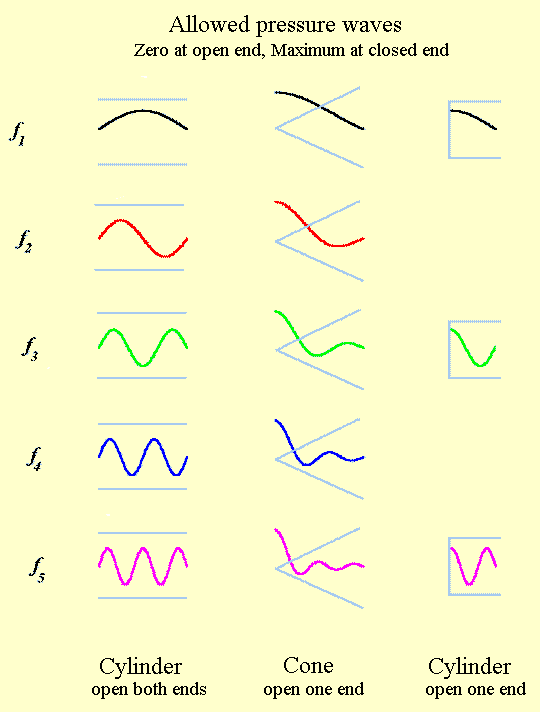

A soprano saxophone and a clarinet are about the same size and are both single reed instruments, but they sound completely different. In addition, the range of a clarinet is rougly one octave lower. While there are other more subtle differences, the main difference is that a clarinet has a cylindrical bore and a saxophone has a conical bore. This difference causes a large difference in the resonant modes, and hence the overtones which can be excited.
For a cylindrical bore, the amplitude of the pressure variations for resonant modes are well described by sine waves. At the ends of an open finite cylinder (neglecting end effects), the pressure variations should be zero (i.e. the ends are a pressure node). At a closed end, the pressure variations should be a maximum (i.e. an "anti-node").
For a conical bore, the amplitude of the pressure variations are not simple sine waves, but are described by sin(x)/x, where x represents a distance (in appropriate units) along the cone, and x = 0 is the apex. As is the case for the closed cylinder, a pressure anti-node must be present at the closed end of the cone, which occurs automatically for the function sin(x)/x, and a pressure node should be present at the open end.
The figure below illustrates (schematically) the pressure variations for a cylinder open at both ends, an open cone, and a cylinder closed at one end. The end conditions for the cylinder closed at one end can only be met by the odd harmonics, and hence all even harmonics are missing from the sound. On the other hand, the cone and the cylinder open at both ends contain both the odd and even harmonics and when the same length, will have the same resonant frequencies.
The frequency for the nth harmonic is fn = n*f1.
In addition, note that to obtain the same fundamental frequency, f1, the cylinder closed at one end is 1/2 the length of the cylinder open at both ends. Hence, if the two were the same length, the closed cylinder would play an octave lower than the open cylinder.
To a first approximation, the clarinet can be considered as having a cylindrical bore closed at one end (by the reed/mouthpiece), whereas a saxophone has a (truncated) conical bore (with the apex near the mouthpiece).

For more detail, including the case of a partial cone with
openings at both ends,
see:
"The conical bore in musical acoustics," R. D. Ayers, L. J. Eliason,
and D. Mahgerefteh, American Journal of Physics, Vol 53, No. 6, pgs 528-537,
(1985).
There are no pop-ups or ads of any kind on these pages. If you are seeing them, they are being added by a third party without the consent of the author.
Comments/questions:
suits@mtu.edu
Physics of Music Notes
Back to MTU Physics Home Page
Copyright Info